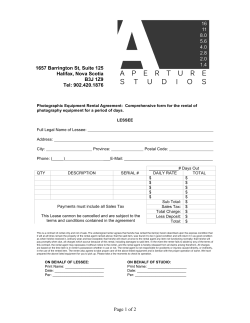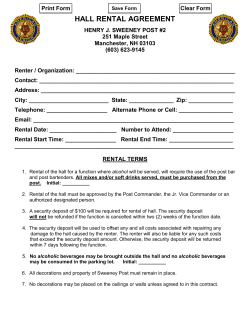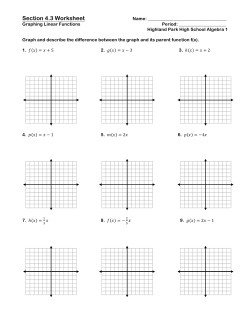
Worksheet A- Individual (Form1038)
Rental Income Worksheet Individual Rental Income from Investment Property(s): Monthly Qualifying Rental Income (or Loss) Investment Investment Property Documentation Required: Property Address Address Schedule E (IRS Form 1040) OR Enter Lease Agreement or Fannie Mae Form 1007 or Form 1025 Step 1. When using Schedule E, determine the number of months the property was in service by dividing the Fair Rental Days by 30. If Fair Rental Days are not reported, the property is considered to be in service for 12 months unless there is evidence of a shorter term of service. Step 1. Result: The number of months the property was in service: Result Step 2. Calculate monthly qualifying rental income (loss) using Step 2A: Schedule E OR Step 2B: Lease Agreement or Fannie Mae Form 1007 or Form 1025. Step 2 A. Schedule E - Part I A1 Enter total rents received. Enter A2 Subtract total expenses. Subtract A3 Add back insurance expense. Add A4 Add back mortgage interest paid. Add A5 Add back tax expense. Add A6 Add back homeowners’ association dues. This expense must be specifically identified on Schedule E in order to add it back. A7 A8 Add back depreciation expense or depletion. Add back any one-time extraordinary expense (e.g., casualty loss). There must be evidence of the nature of the one-time extraordinary expense. A9 A10 Add Add Add Equals adjusted rental income. Total Divide by the number of months the property was in service (Step 1 Divide Result). Equals adjusted monthly rental income Total Subtract proposed PITIA (for subject property) or Subtract existing PITIA (for non-subject property). Step 2A. Result: Monthly qualifying rental income (or loss): Result Step 2 B. Lease Agreement OR Fannie Mae Form 1007 or Form 1025 This method is used when the transaction is a purchase, the property was acquired subsequent to the most recent tax filing, or the lender has justification for using a lease agreement. B1 B2 B3 Enter the gross monthly rent (from the lease agreement) or market rent (reported on Form 1007 or Form 1025). For multi-unit properties, combine gross rent from all rental units. Multiply gross monthly rent or market rent by 75% (.75). The remaining 25% accounts for vacancy loss, maintenance, and management expenses. Equals adjusted monthly rental income. Subtract proposed PITIA (for subject property) or existing PITIA (for nonsubject property). Step 2B. Result: Monthly qualifying rental income (loss): Enter Multiply x.75 x.75 Total Subtract Result Step 3. Determine the qualifying impact using the result of Step 2A or Step 2B. If the combined result of Step 2A or 2B is positive, add the positive amount to the borrower’s monthly qualifying income. Because the PITIA expense was included in the calculations above, do not add it to the debt-to-income (DTI) ratio. If the combined result of Step 2A or 2B is negative, include the amount of the loss in the borrower’s monthly expenses when calculating the DTI ratio. DU Data Entry Monthly Income and Combined Housing Expenses Subject Property Non-Subject Property Enter the amount of the monthly qualifying income (positive result) or monthly qualifying loss (negative result) in “Subject Net Cash.” Enter the amount of the monthly qualifying income (positive result) or monthly qualifying loss (negative result) in “Net Rental.” Mortgage Liabilities For refinance transactions, identify the mortgage as a subject property lien. Identify the mortgage as a rental property lien. Refer to the Rental Income topic in the Selling Guide for additional guidance. Fannie Mae Form 1038 09.30.2014
© Copyright 2025










